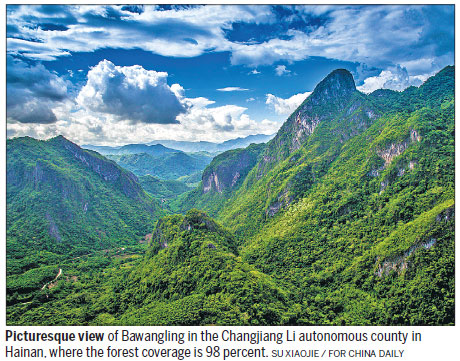Hainan, an island province with a 1,823 kilometer-long coastline, is appointing bay chiefs and establishing a bay management and protection responsibility system, to better safeguard its marine ecology, according to the provincial government.
The decision is considered an important step in implementing the central government's new development concept and requirements for ecological civilization construction. It highlights the strengthened management of sea area usage and the protection of Hainan's coastlines.
The bay chief system is a three-level governance system, with top officials serving as general bay chiefs.
The bay chiefs' responsibilities include pollution prevention and control, marine ecological restoration and environmental monitoring.
The reclamation of sea areas is now strictly forbidden if the activity does not restore marine ecological systems. Some key State or provincial infrastructure projects meeting environmental standards are allowed.
Hainan's long coastline is regarded as one of the most important ecological circles and the province's most beautiful asset, with ecological functions and resource value beyond comparison. But, it needs better protection. Over 800 cases of illegal bay area usage were identified in an inspection in 2015.
Comprehensive restoration work will be conducted to help keep the bays blue, while pollution from local ports and ships will be strictly controlled, according to the new rules, which encourage the use of sea areas in a legal, ecological, scientific and efficient way.
Haikou, the provincial capital, will be the first to introduce chiefs to take care of its bay resources.
The city is among China's first batch of five pilot cities to practice the new system, which will be performed in close coordination with the country's river chief strategy. The latter system has been effective for several years and has a strong team of 200,000 designated river chiefs responsible for dealing with water pollution, according to the State Oceanic Administration.
The other four areas on the pilot list are Qinhuangdao in Hebei province, Jiaozhouwan in Shandong province, Lianyungang of Jiangsu province and Zhejiang province as a whole.
As a pilot city, Haikou has implemented the system to strengthen its conservation efforts, improving the city's marine environment, maintaining ecological security and boosting sustainable development of its bay resources.
The coast city governs many islands and bays, including Haikou Bay, Jinsha Bay and Puqian Bay, with their water areas covering 830 square kilometers and a coastline stretching 136.2 kilometers.
Haikou aims to establish a green and recyclable low-carbon marine industry structure by 2019. By then, the quality of the city's marine environment will be further improved and the service function of the marine ecology upgraded.
The city will also brighten its coastal landscape and upgrade its capacity to prevent marine disasters.
Statistics show that Haikou's marine GDP reached 29.8 billion yuan ($4.58 billion) last year, accounting for 26 percent of the total marine output of the province, and ranking No 1 among Hainan's 18 cities and counties.
The province's marine GDP was 116.3 billion yuan in 2016, 28.2 percent of its total GDP.
Although a major driver of the city's economic growth, the marine environment remains fragile, according to an official from Haikou marine and fishery department.
In response to the situation, Haikou is setting up a joint prevention and control mechanism to protect its river and marine environments, according to the city strategy.
"Marine pollution is not an isolated problem. Resolving river pollution is the first step in protecting the marine environment, and the bay chief system is an adaptation of the river chief system," the marine official said.

Wild deer forage for food in the Datian National Reserve Area in Hainan province. Su Xiaojie / For China Daily

(China Daily 10/23/2017 page12)